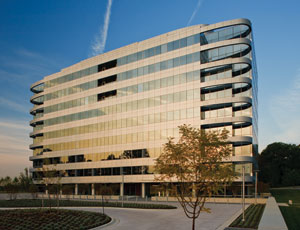2000 Tower Oaks Boulevard in Rockville, Md., is a 200,000-sq-ft, nine-story Super Class A commercial office building. One of the two developers is The Tower Cos., a real estate firm that also has its LEED platinum headquarters on the building’s ninth floor. The office property is built in a 200-acre park setting, where two-thirds of the property is set aside as preserved woodland and open space.

The building incorporates Vedic architectural design principals of orientation, placement and proportion, which determine how the structure relates to the body, mind and environment. This project is the first commercial building of this magnitude to incorporate Vedic principles.
Tenant amenities include a fitness room, yoga/Pilates room and an organic café. The building offers dedicated parking for hybrid and low-emission vehicles. More than 17,000 drought-resistant native plantings of trees, ornamental grasses and flowering bulbs compliment the building’s landscape.
Platinum Points The owners’ original goal for 2000 Tower Oaks Boulevard was to achieve LEED gold certification. As the design progressed, the design team incorporated additional sustainable elements to support the end-goal of a healthy and sustainable building for its occupants. Additional elements that pushed the project to a LEED platinum certification include:
Architect: Kishimoto.Gordon.Dalaya PC, Arlington, Va.
MEP Engineer: TOLK Inc., Fairfax, Va.
Civil Engineer: Site Solutions Inc., Germantown, Md.
Landscape Architect: Oculus, Washington, D.C.
Lighting Designer: Moran Coventry Lighting Associates, Washington, D.C.
Energy Modeling Consultant: EMO Energy Solutions, Falls Church, Va.
Owner: The Tower Cos., Rockville, Md.; and Lerner Enterprises, Rockville, Md.
General Contractor: The Whiting-Turner Contracting Co., Chantilly, Va.
- Purchase of Green-E certified Renewable Energy Certificates for 100% of total annual electric energy usage.
- Reduction of total building energy consumption by 28%.
- HVAC system circulates at least 30% more outside air than required by code.
- Outdoor airflow devices and CO2 monitors to adjust fresh air flow.
- Waterless urinals and low-flow showers and faucets, resulting in a 41% reduction in building water consumption.
- Use of drought-resistant plantings that reduce the required water for irrigation by 60%. Condensate water provides 100% of the building’s irrigation needs.
- An onsite bioretention pond that captures and treats stormwater runoff. The pond also captures and treats runoff from nearby Interstate-270.
- 22% of the building materials contain recycled content.
- 23% of materials were extracted and manufactured within a 500-mi radius.
- More than 85% of construction waste was recycled.
Biggest Challenge When design began, no federal subsidies or incentives were available for incorporating green technology. Many materials meeting the LEED credit requirements weren’t widely available in the marketplace, and green technology was still generally perceived to drive up costs without return.

Post a comment to this article
Report Abusive Comment